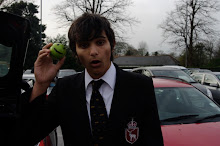Preliminary Task Analysis:
Our preliminary task was a short 45 second film about a man trying to change the world. It was filmed and edited by our group with two of us filming the sequence and two of us starring in it.
The first step in making our preliminary was to sit down as group and discuss what our preliminary short film was going to be. After brainstorming some ideas we drew up a very brief storyboard as a general guide and frame for what we were going to shoot, a short film entitled ‘Hunger.’ We made a storyboard which consisted of 12 shots, this storyboard was only a rough guide but was rather crude and vague which made us suffer problems later on when deciding which shot/camera angle we had chosen to use when we wrote the storyboard as we did not make it clear enough.
The film was shot in our school over the course of a one hour lesson. This was an easy location to shoot from as we knew it very well and could decide on the best locations to use. It was also available as we were already near possibly shooting locations making it possible to shoot our film quickly and with short notice.
For our Preliminary task we used 2 low quality Mini DV cameras. We decided to use 2 as it enabled us to be able film our action match as we were cutting from the same action on screen but between two different camera angles which we did for our dialogue sequence.
Overall the shoot went quite well. The composition of most shots was generally quite good. Problems arose with composition mainly due to the rule of thirds not being followed on some shots, this is something we will take into consideration when it comes to the main task. Another problem we faced camera shake as we did not use tripods for our preliminary task, this is something we plan to avoid in the main task by using tripods. The sound quality on our short film was not a very good standard, we plan to overcome this by using directional microphones which will be used with the cameras. The main problem we faced in the shoot was the general competency of the group, the shoot took longer than planned because we did not find a room to film in in advance meaning we wasted a lot of time looking for free class rooms to film in. This was due to the lack of organisation in the pre production stage of our short film.
Another problem we faced to do with the incompetency of the group was the forgetting of lines which can be put down to the lack of organising we did before we decided to shoot.
One of the things that went quite well was the editing process using Macbook Pro's and Final Cut Express 4. We were able to add fade’s and titles to our piece. The rules of continuity editing were strictly followed and we managed to execute it quite well. We added non diegetic music to our preliminary task to fill in silence, it was successfully ducked at the right moments so that dialogue could be heard, although the audio quality was not of a high standard in the first place due to the camera’s we used. We wanted to add titles to our sequence but because we did not have the correct level or technical knowledge to maneuver Livetype, therefore we had to export our sequence to iMovie to add titles which lowered the video quality as it had to be compressed each time.
Our Task went reasonably well, there were some problems we encountered but these were mainly due to the lack of organisation on the shoot. It was all quite inefficient was we did not know what shots needed to be done because our storyboard was not at a high enough standard, other things such as camera shake due to the lack of tripod and some minor problems with sound, are the main problems we faced during our shoot. It was a test of our organisational skills and really showed us what will be required for the task up ahead and showed us ways we can improve which, without doing the preliminary, we probably wouldn't have learnt.
A few screen grabs of the editing process shows our stages of editing:

- We used Final Cut Express 4 on a Macbook Pro to edit 'HUNGER'

- We added non-diegetic music to our film

- This music was ducked so that the audio dialogue from the footage was audible

- The footage faded out to at the end to draw the film to close
The Final Preliminary Task



